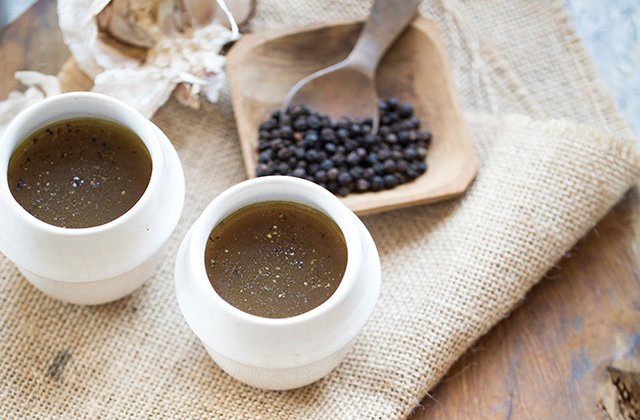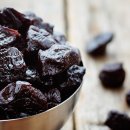
The health benefits of bone broth
The health benefits of bone broth

Whether you’re drinking it as an elixir, sipping it as a snack or simply cooking with it, bone broth is everywhere. And it’s not so much a case of what we have heard about it, but what we haven’t. There are claims that bone broth eases inflammation and allergies, supports immunity and has the capacity to ‘heal’ your gut.
While much of the fanfare is new, the use of broths to comfort and nourish is not. Bone broth has long been used as a folk-remedy – think chicken noodle soup or what’s known as ‘Jewish Penicillin’ (a version with ‘matzo balls’: chicken fat, breadcrumbs made from unleavened bread and eggs mixed into comforting, doughy dumplings). Then there’s Korean seolleongtang (ox bone soup) and Chinese gao tang (a generic term for leftover bone soup). In culinary traditions all around the globe, stocks and broths are considered staples. Not only that, these are the comfort foods our grandparents and parents gave us as children, especially when we were ill. However, the medicinal (dare we say, healing) benefits of bone broth run deeper than the comfort of a hot bowl of soup.
What is bone broth?
Both stocks and broths are built on the same basic principles: water, meat or bones (or both), vegetables and seasoning. The difference between them really comes down to the amount of meat and the cooking time.
Stock vs. broth – is there a difference?
• Broth – mostly made with meat and a small amount of bones (e.g. an entire chicken) and is cooked for one to two hours resulting in a light and thin broth.
• Stock – mostly made with bones and a small amount of meat (e.g. scraps adhering to bone) and is cooked for three to four hours.
• Bone broth – made with bones and a small amount of meat (again, small scraps adhering to bone) and is cooked for eight to 24 hours.
The nutritional component of bone broth that is held in highest regard is gelatine. Gelatine is derived from the breakdown of collagen (the connective tissue of muscle and most abundant protein in the human body) and is rich in the non-essential amino acids glycine and proline. Glycine is a primary nutrient required to fuel the secondary detox pathway of the liver. It’s also one of the three amino acids that make up glutathione – a key antioxidant in the body that’s essential for vitamin C metabolism, free radical protection as well as alcohol and heavy metal detoxification.
The act of slowly simmering bones and ensuring a low, consistent heat is just enough to break the hydrogen bonds of the collagen from the animal without reducing or damaging the gelatine properties. In the process, minerals are also extracted from the bones themselves. These include calcium, magnesium and phosphorous, which our bodies can use for key enzymatic reactions, bone health and to maintain fluid balance.
Other compounds could include proteoglycans within cartilage, namely chondroitin sulfate, a famed supplement used for joint pain and osteoarthritis.
So, how healthy is it?
While some of the health claims around bone broth can be backed up by science, others…well…can’t be. Although we can roughly know what’s contained within a well-prepared bone broth, there is an inevitable lack of standardisation in ingredients and cooking time, and therefore it becomes difficult to study comprehensively. For instance, chemistry tells us that to extract minerals from bone a weak acid (such as vinegar) is required. However, how many prepared bone broths take this step is unknown.
Results, therefore, are very difficult to reproduce in a lab environment. And studies are thin to non-existent when it comes to the nutritional benefits of bone broth. The commonly referred to claims of bone broth often cite supplement-focused studies. For instance, studies where chicken collagen has been extracted and provided to osteoarthritis patients with positive results on both pain and activity scales, or studies on human intestinal cells where the use of a lab-made product, gelatine tannate, has produced an anti-inflammatory response.
Traditional Chinese medicine (TCM) documents the use of donkey hide gelatine (colla corii asini in Latin or e-jiao in Chinese) to increase the number of red blood cells and provide anti-ageing properties. However, in these studies the source of the gelatine has been questioned and, overwhelmingly, the usage points to extracted supplement forms – not bone broth.
What you can expect
Generally speaking, a well-prepared bone broth will contain the aforementioned minerals, and we know how they function in the body. For instance, magnesium is involved in almost every reaction in the body, is key for nervous system support, is used in clinical practice to soothe the gut mucosal membrane and therefore also supports immunity in compromised individuals. It’s important to note, though, that while these nutrients (such as magnesium) are highly valued in the body for a variety of areas, the amounts contained within bone broth are not standardised and can therefore vary widely.
However, there’s a lot to be said for the synergistic benefits included in bone broth. As valuable as gelatine has shown to be in the body, commercially available gelatine is typically derived from animal skin and therefore will not contain the minerals typically found in bone broth. And though the amount of relevant research available right now is insubstantial, many of the conclusions and claims drawn about bone broth make scientific sense.
Unfortunately, on the immunity front, while there are absolutely nutritional factors that can alter immune responses in our body (e.g. inadequate essential fatty acid or specific amino acid intake), bone broth’s properties should not be considered as a cure-all or replacement for sound and balanced nutrition. At the same time, any form of malnutrition can impair our immune status and opens us up to a variety of health problems. That’s precisely why bone broth, as a liquid food well suited for convalescence when other foods have lost their appeal, is a good source of protein and minerals.
As always, health and wellbeing is not a one-size-fits-all philosophy and a balanced, varied diet alongside individual recommendations always comes out on top. For personal advice we recommend seeing a university-qualified nutritionist.















